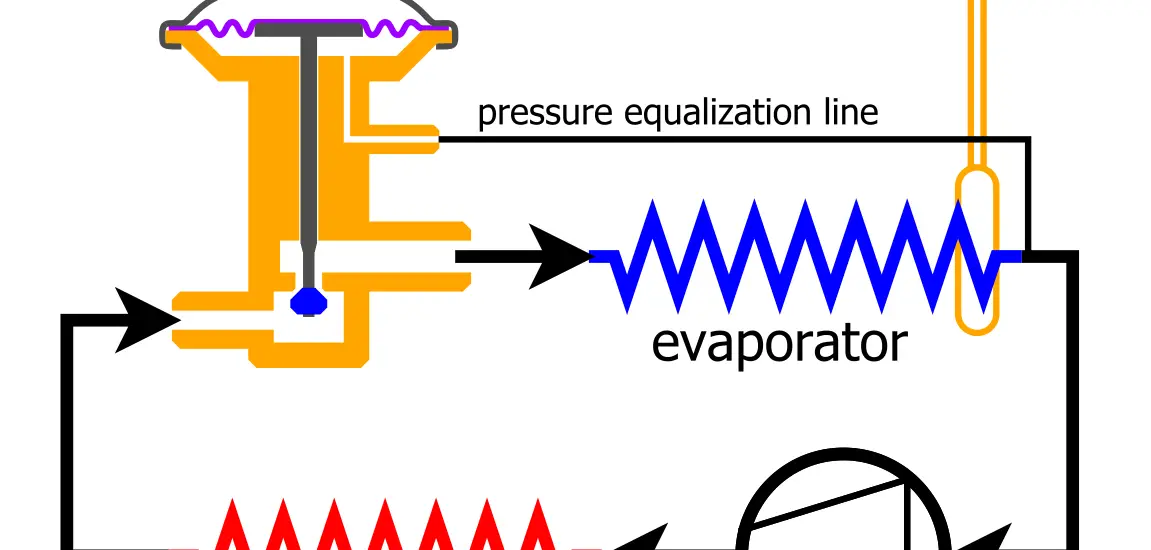This article will help you recognize the symptoms of a stuck TXV early on to prevent more severe issues down the line.

Table of Contents
Key Symptoms of a Stuck TXV
In this section, we’ll reveal the key symptoms of a stuck TXV:
Reduced cooling or heating capacity of the system
The most notable sign is a sudden decrease in the system’s ability to cool or heat the surroundings. This happens due to the refrigerant not being able to flow correctly, leading to diminished performance. It is like having a water pipe that is partially blocked, where the water flow is not at its optimal level.
Increased suction pressure and reduced discharge pressure
In a normal scenario, the TXV maintains a certain balance of pressure in the system. However, when it is stuck, the suction pressure increases while the discharge pressure reduces. This is akin to a road traffic system; a blockage at one point can cause a backlog in one area and a reduction of traffic in another, creating inefficiencies in the flow of traffic.
Fluctuating superheat values
The TXV is designed to maintain a precise superheat value to ensure the system’s efficiency. A stuck TXV can cause this value to fluctuate unpredictably. Imagine trying to maintain a steady temperature on your shower with a faulty valve; the temperature would either be too hot or too cold, constantly changing and never just right.
Frost formation on the evaporator coil or suction line
Proper refrigerant flow prevents frost formation. A stuck TXV can disrupt this flow, leading to frost on the evaporator coil or suction line, much like how a freezer can get frosted over when the door is not sealing properly.
Higher than usual evaporator temperatures
Normally, the TXV helps in controlling the evaporator’s temperature. When it is stuck, the evaporator temperatures can soar higher than usual, signaling a malfunctioning TXV. This can be compared to a car overheating when there is a problem with the cooling system.
Causes of a Stuck TXV
Understanding why a TXV gets stuck can be a vital part in troubleshooting the issue. Various factors could be at play and we will break down each one of them for better comprehension:
Debris or contamination in the system: Over time, small particles and contaminants can accumulate in the system, blocking the TXV and preventing it from functioning properly. Think of this as a strainer in your kitchen sink getting clogged with food particles over time, impeding the flow of water.
Valve pin sticking due to mechanical issues: Sometimes, the valve pin inside the TXV can get stuck due to mechanical problems, much like how a door hinge might get stuck, preventing smooth operation.
Normal wear and tear over time: Like any other machine part, the TXV can undergo wear and tear over time, affecting its performance. Regular maintenance can help in increasing its lifespan.
Check out these other articles…
Checking Superheat with TXV: In 5 Easy Steps
How to Check Superheat on TXV: Your Step-by-Step Guide
TXV Hunting: Your Comprehensive Guide
Electronic Expansion Valve Types: The Full Breakdown
TXV Superheat or Subcooling: A Comprehensive 411 Comparison
How to Address the Issue
If you find yourself facing issues that point towards a stuck TXV, it is important not to panic. Here are step-by-step guidelines on how to proceed:
Consult a professional: The first step is always to consult with a trained HVAC technician. They can use specialized tools to diagnose the exact problem.
Diagnostics: The technician will likely perform a series of diagnostics tests to understand the root of the problem better. This can include checking the pressures in the system, examining the TXV for physical damage, and other relevant assessments.
Solution implementation: Based on the diagnostics, the technician may suggest a series of solutions such as cleaning the valve to remove obstructions, repairing mechanical issues, or replacing the TXV entirely to remedy the situation.
System Testing: After the necessary repairs or replacements have been carried out, the technician will test the system thoroughly to ensure that it is functioning properly before handing it back over to you.